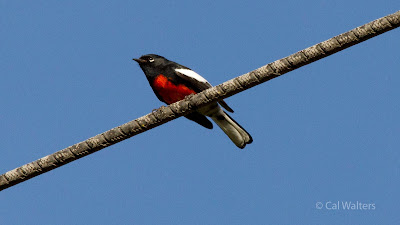 |
| Enchanted forest path |
At the Orinda Connector Staging Area, where Wildcat Canyon and Bear Creek Roads meet super-busy San Pablo Road, with tony suburban communities sprawling in all directions, I ditch my bike in a thicket and sign in at the East Bay Municipal Utility District's check station.
 |
| EBMUD sign-in station |
(Note to welcome visitors: please pay your EBMUD permit fee and carry it with you when passing onto watershed district land. And always obey the rules.)
 |
| Thank you, EBMUD |
Unknown to most who pass this way (thousands of cyclists and motorists), some of EBMUD's 27,000 acres of vast and varied East Bay landscape lies hidden just below this major juncture.
 |
| Wild Turkey foraging in grassland |
Head out on a short or all-day outing exploring recreational reservoirs (San Pablo and Briones) and old Salmon run tributary streams (Bear and San Pablo Creeks), accessed via miles of hiking and equestrian trails.
 |
| Glimpse into San Pablo Creek's bird-rich back stretches |
When in need of some good old-fashion soul-calibrating solitude, nothing beats a few hours alone in this small, rich, biodiverse slice of habitat that instantly enchants with its riparian zones, meadows and woodlands.
 |
| Dried-out flood zone rich habitat for Herons and Geese |
A matrix of EBMUD trails connect to the greater Bay Area beyond, out Old San Pablo Trail for 5 miles, or test your mettle hiking nearly 15 miles on Oursan and Bear Creek Trails, circumnavigating the 60,510 acre ft. flat-out (hilly-out?) beautiful Briones Reservoir, notably called out by San Francisco Chronicle Outdoors writer Tom Stienstra as:
 |
| A dripping wet little unidentified Sparrow |
" . . . the bluest body of water in the Bay Area."
 |
| Briones Reservoir viewed from the Berkeley Hills |
Some may wonder, what's the fuss. And maybe they're right. After all, my sphere of exploratory wandering / casual go-nowhere investigations encompasses an area no larger than a couple of acres. But these couple of acres truly pack in a ton of stimuli!
 |
| San Pablo Creek mystique |
Ignoring the din of commuter traffic speeding on San Pablo Dam Road toward the Bayshore cities of El Sobrante, Hercules and Richmond, I immerse in my suddenly lush and sylvan surroundings and focus my attention on other things:
 |
| Black Phoebe in a bayou-like back stretch of the creek |
Such as communing with tall, old sycamore, pine and oak trees, which provide high canopy for a myriad of unseen birds, infinite, hidden well.
 |
| Rich tree top canopy provides shelter and food for birds |
Secondary understory and dense shrubbery shelters sweet flowing San Pablo Creek. A short stroll reveals open thistle-choked meadow intermixed with scrubland, bordered by thickets of dogwood and remnant apple trees from an old homesteader's orchard.
 |
| Biodiverse habitat shelters many animal and plant species |
It all makes for a perfect bird sanctuary and all-around nature lover's intimate experience; notwithstanding, the few people I have seen here are always on the move, hiking, running or horseback riding.
 |
| Dangling leaf |
Very few, if any people stopped in their tracks – "doing nothing" except looking for birds and their presence – nests, feathers, egg shells, bones, mystery tweets deep in the brush or high in tree tops.
 |
| Hawk feather |
Moi? I choose to stick close by in my wondrous single little acre contained within an miniature paradise. (What's all the fuss about, now?) After signing in, I'm immediately stalled by furious bird activity!
 |
| Chestnut-backed Chickadee in the mix |
Vivacious Chestnut-backed Chickadees here. Vibrant Ruby-crowned Kinglets there. Juncos, Jays, and ground foraging Sparrows getting in the mix. Then – a novel sight! Can it be? Yes, it’s a Golden-crowned Kinglet, my first ever spotted in the Bay Area and only the second time I’ve ever seen the tiny, hard-to-spot bird.
 |
| Golden-crowned Kinglet motionless for less than a second |
I'm truly amazed to see a Golden-crowned Kinglet making an appearance, and then hanging around for ten minutes flitting about and – dare I say? – flirting with me!
 |
| Lucky capture of the Golden-crowned Kinglet |
What’s crazy about the bird’s “mystique” is that it’s a fairly common bird, 100,000,000 strong, and is a frequent visitor to Bay Area coniferous and deciduous habitats . . . and yet, it's almost like a crypto-avian, this elusive little, seldom-seen (by me only?) bird!
 |
| Spotted Towhee screeching at something |
After that thrilling sighting, what next, I wonder.
Here in the mixed forests of San Pablo Creek and Watershed,
you never know what surprises await.
 |
| Hermit or Wood Thrush? (I never can tell!) |
San Pablo Creek is a primeval water course that once channeled tons of salmon, which in turn attracted Grizzly Bears and Bald Eagles, but, alas, no more, although San Pablo Reservoir is one of 6 sites in the 40-square mile Bay Area supporting nesting Baldies, which gives you a good idea of this place's nature quotient.
 |
| There's just something about San Pablo Creek |
Lolly-gagging along the surprisingly swift-flowing creek and diverting up to scrubby meadow edges allows for a field day for spotting my fav birds – over 20 species!
 |
| California Towhee hiding out |
Mostly common characters, but each of them a joy to encounter, observe and admire as they go about their unseen, infinite, hidden well business in their own private paradise.
 |
Bird magnets
|
So, you tell me:
what's all the fuss about, anyway?
 |
| Squat little White-crowned Sparrow |
After all, they're just birds bein' birds.
 |
| Follow, follow, follow the dirt path |



.jpg)

.jpg)
.jpg)





.jpg)

.jpg)


.jpg)






.jpg)











































.jpg)
